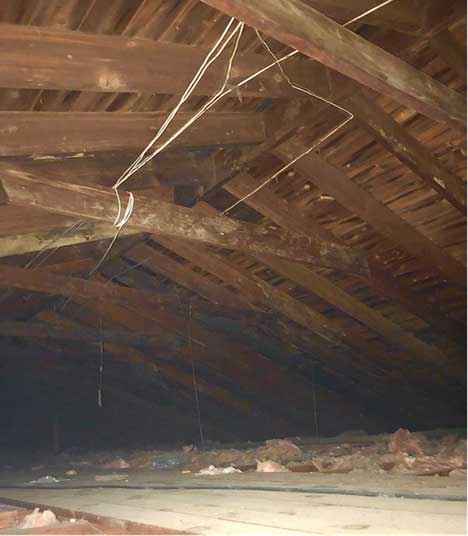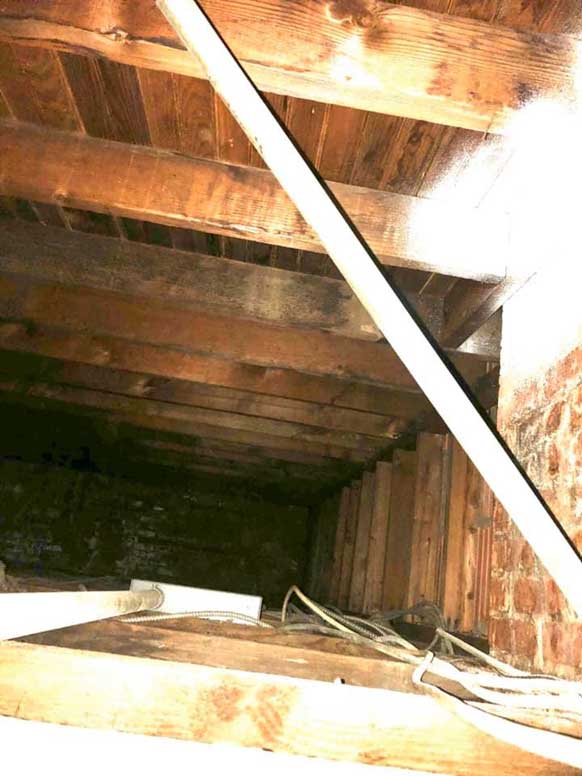Within three types of building construction, firefighters are faced with the inherent dangers of combustible void spaces. Whether it be pipe chases, chutes, knee walls, cocklofts, balloon framing, attic spaces, truss lofts, joist and stud channels, or soffits, we often see these areas are subject to hidden complex fires that are often hard to immediately mitigate, or even see readily.
One of the questions often asked is: “What is the difference between an attic and a cockloft?” This is a great question. To most, these elements would otherwise appear to be very similar. Both are between the top floor ceiling and the roof. Both often have limited ventilation, lighting, or windows. Both often have exposed, unprotected lumber. Most important, both consist of a confined and limited egress environment. In firefighting, the buildings we enter often dictate the tactics and practices. With this in mind, it is important to elaborate on the difference in both the construction and the fire-related risks associated to effectively size-up and formulate sound practices when fires occur in these combustible void spaces. Let’s take a look…
PITCH: The angle measured in degrees at which a roof is sloped.
SLOPE: A horizontal surface where one side is higher than the other.
THE ATTIC within a building is often created by peaked roofs using combustible construction. Roofs that are pitched more than 15° or have two slopes meeting at one or more points create the attic space. Attic spaces are different from cocklofts primarily because of one major factor—they have the ability to be inhabited. Attics can be finished or unfinished. We often see that finished attic spaces incorporate gypsum board, flooring, doors, staircases, limited windows, knee walls, and on occasion even bathrooms. (1)

Unfinished attic spaces do not incorporate the previously mentioned finishings. Windows are often replaced with small vents, open floors (no decking), exposed rafters and ceilings, utilities such as HVAC systems, inline water heaters, limited lighting, and two of the most significant factors: the use of the space for storage, and often times limited means of access via the use of pull-down ladders or hatchways. (2)

Now obviously the latter presents more of a danger to our firefighters. Unprotected, dry, old lumber and an open void space provides a significant structural fire load. Open floors make advancement into this area extremely dangerous, as beams could not only be weakened by fire but the weight of firefighters could cause compromise due to dry rot or splitting. HVAC systems can become dislodged, disconnected, or create the prescription for structural failure if collapse occurs. Dropdown ladders are not designed to support the weight of firefighters and will certainly fail if overloaded. In addition, with an advanced fire, these ladders will most likely be burned away or locked in place. The most significant problem is limited egress. Firefighters who advance into the unprotected attic space often place themselves in a vulnerable position, on top of everything else previously mentioned.
Training Minutes: Knee Wall Fires
Construction Concerns: Interior Void Spaces
Concealed Spaces and Fire Spread

Finished attic spaces present often with knee walls or walls that close off where the pitch meets the floor line. They are usually about three- four feet in height and most often are not protected by gypsum board, thus creating a combustible void space that runs the length of the building. These knee walls often are jam packed with storage items forgotten by the homeowner. There’s also the possibility of HVAC systems within. (3). Fire that grows within the knee walls can go undetected, so it is imperative that the knee walls are checked early to avoid structural compromise of the rafters.

THE COCKLOFT is a horizontal combustible void space between the top floor ceiling and the roof. (4) This presents an open void space that allows unimpeded fire travel throughout the length of a building. The cockloft can vary in height and is not an inhabitable space. The cockloft is designed to trap heat at the upper levels and disperse through the use of multiple cockloft vents. Utilities in this space are limited to piping and electrical. There is usually no access to the cockloft from below, thus vertical ventilation in conjunction with opening up a ceiling with a hand line is usually practiced. Cockloft roofs incorporate a sloped roof, from front to rear, or with the use of drains at intersecting slopes. Fire within a cockloft can be discovered only by the use of sound inspection tactics. We often see cocklofts in ordinary constructed commercial occupancies, combustible construction within row frames or brown stones (private dwellings), or in heavy timber structures that have been renovated. Cocklofts can span over the tops of multiple apartments or stores, and due to their limited ventilation design, smolder and create the prescription for cockloft explosion when vented from beneath.
SALVATORE ANCONA is a deputy chief fire instructor at the Nassau County (NY) Fire Service Academy; a member of the Seaford (NY) Fire Department; a former captain and training officer for the Bellmore (NY) Fire Department; and a paramedic supervisor in Queens, New York. He has an A.S. degree in fire science from Nassau Community College and has a bachelor’s degree in fire and emergency services administration from John Jay College of Criminal justice. Ancona is the author of the building construction page “The Sons of Brannigan” on Facebook and was a recipient of the 2019 FDIC International Honeywell DuPont Scholarship.
MORE
Firefighters and Construction: Beams and Girders: How They Fail
Firefighters and Construction: Primer on Collapse in Noncombustible Buildings

